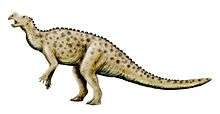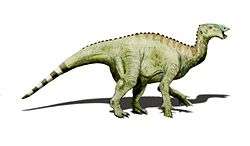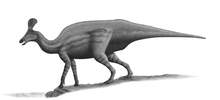Bolong
Bolong (meaning "Bo's dragon") is a genus of iguanodontian dinosaur known from the Early Cretaceous-age Yixian Formation of western Liaoning Province, China.[1] It lived about 125 million years ago in the earliest Aptian.[1]
| Bolong | |
|---|---|
| Scientific classification | |
| Kingdom: | Animalia |
| Phylum: | Chordata |
| Clade: | Dinosauria |
| Order: | †Ornithischia |
| Suborder: | †Ornithopoda |
| Clade: | †Hadrosauriformes |
| Superfamily: | †Hadrosauroidea |
| Genus: | †Bolong Wu, Godefroit & Hu, 2010 |
| Species: | †B. yixianensis |
| Binomial name | |
| †Bolong yixianensis Wu, Godefroit & Hu, 2010 | |
Discovery and naming
It was named by Wu Wen-hao, Pascal Godefroit and Hu Dong-yu in 2010 and the type species is Bolong yixianensis.[1] The genus name is derived from the names of the brothers Bo Hai-chen and Bo Xue, who helped uncover it, and the Mandarin word 龍 lóng "dragon". The specific name refers to the Yixian Formation which is where is Liaoning it was found.[1]
The holotype fossil, YHZ-001, consists of a skull with lower jaws from which a middle portion is missing. The fossil was highly compressed.[1]
In 2013 a second specimen was described, ZMNH-M8812, consisting of an almost complete skeleton of a very young animal. It was found by a farmer in the village of Xitaizhi.[2]
Description
Bolong was a relatively small animal with an estimated length of four meters and a weight of 200 kilograms. The head is convex and fairly stocky with powerful mandibles. The teeth are relatively large. Different autapomorphies (unique derived traits) that can be established are: a cavity at the interface of the lacrimal bone, the maxilla, the backwards branch of the prefrontal bone, consisting of a front-to-rear depth cavity above the edges of the eye socket, the lower protrusion of the predentarium extending rearwardly parallel to the lower edge, the interface of the predentarium that occupies less than two-thirds of the height of the dentarium so that the front tip of the dentarium protrudes a third above the predentarium, and that the teeth in the maxilla have dental crowns of which the main ridge bends at the tip of the tooth.[1]
The second specimen showed a different autapomorphy: the inside of the maxillary teeth are thickened and enclosed from the front and rear cutting edges and is divided in half by a striking vertical ledge.[2]
Phylogeny
The describers placed Bolong in Hadrosauroidea. It would have been one of the most basal hadrosauroids found in Asia.[1]
References
- Wu Wen-hao; Pascal Godefroit; Hu Dong-yu (2010). "Bolong yixianensis gen. et sp. nov.: A new Iguanodontoid dinosaur from the Yixian Formation of Western Liaoning, China". Geology and Resources. 19 (2): 127–133.
- Zheng; Wenjie; Jin; Xingsheng; Shibata; Masteru; Azuma & Yoichi (2013). "An early juvenile specimen of Bolong yixianensis (Ornithopoda:Iguanodontia) from the Lower Cretaceous of Ningcheng County, Nei Mongol, China". Historical Biology. doi:10.1080/08912963.2013.809347.







.jpg)